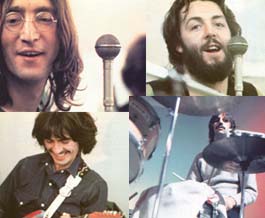 LET IT BE
LET IT BE
Director: Michael Lindsay-Hogg
The final movie in the Beatles' deal with United Artists began as a rehearsal for their return to the concert stage after three eventful years and ended as a meager consolation prize for fans in the wake of the group's breakup.
After the personality clashes that erupted during the White Album sessions, Paul devised a scheme to return the Beatles to their former state of co-operation and comradery. The band would rehearse for a concert featuring all new material rather than tried and true hits and the rehearsals would be filmed for a television documentary. The show was envisioned as taking place in such exotic locations as a Tunisian amphitheatre, the Sahara desert at sunrise, or on a cruise ship in the middle of the ocean - although in the end venues close to home received more serious consideration. The concert would be filmed for theatrical release and recorded for release as the next Beatles album. The album would be packaged with a book of still photographs from the TV and feature film. Ideally, he planned for the record, book, TV special and movie to be released simultaneously - a dramatic show of force from the Beatles, the undisputed pacesetters in music, hairstyles, clothing and political opinion.
Paul booked the cavernous Twickenham Film Studio for the first two weeks of January 1969, summoned the Beatles and hired a film crew. Twickenham, however, proved drafty, impersonal and unispiring, especially because the cameras peeped over the band members' shoulders from dawn until dusk. The other Beatles weren't sure they wanted to perform untested material. In fact, they weren't sure they wanted to perform at all. They couldn't decide whether to prepare for a concert or develop new songs for an album. Tempers flared. At one point, George walked out on the band. He returned after a few days and persuaded the others to invite Billy Preston, a friend from the Hamburg days, to sit in on keyboards, thus ensuring their civil behaviour.
Facing growing resistance, Paul attempted to salvage the notion of a concert by scaling back the plan to an impromptu performance outdoors on the roof of Apple's offices. In order ro record the album, the Beatles moved the production to their own studio, hastily assembled in the Apple basement. The TV documentary and concert film collapsed into a humble feature, providing a handy way of fulfilling the Beatles' obligation to supply United Artists with a successor to Help! and A Hard Day's Night.
In one month's time the Beatles generated ninety-six hours of film, from which director Michael Lindsay-Hogg was to create a documentary of the events. (Meanwhile, George Martin and engineer Glyn Johns were left with the ninety-six hours of mono soundtrack and over thirty hours of multitrack tape, which contained take after take of the songs that would appear on the Let It Be album.)
Lindsay-Hogg's film was only partially successful. Despite a few interesting moments - George's temper tantrum, the rooftop performance, the Beatles and Billy Preston's jam session in the Apple basement - the film fails to convey the significance of January 1969.
However, it does provide one piece of a puzzle that, when assembled, offers a unique window into the private world of the Beatles and an opportunity to examine great artists at work that is, perhaps, entirely without parallel. When the official movie, record and book are combined with sprawling archival remnants of film and tape that have surfaced in bootleg form, the picture is vivid indeed. Four extroadinarily talented, desperately ambitious and thoroughly weary artists who have reached the limit of historic collaboration and must now carry on as individuals.
Let It Be met with a poor reception from both fans and press. It did, however, win an Academy Award in 1970 for Best Original Song Score.
On the Apple rooftop, the Beatles play "Get Back", "Don't Let Me Down", "I've Got A Feeling", "One After 909" and "Dig A Pony".
In the studio, either in jam sessions or in properly rehearsed performances, the Beatles perform "Piano Theme" (McCartney), "Don't Let Me Down", "Maxwell's Silver Hammer", "Two Of Us", "I've Got A Feeling", "Oh! Darling", "One After 909", "Jazz Piano Song" (McCartney-Starkey), "Across The Universe", "Dig A Pony", "Suzy Parker" [as "Suzy's Parlor"] (Lennon-McCartney-Harrison-Starkey), "I, Me, Mine", "For You Blue", "Besame Mucho" (Valazquez-Skylar), "Octopus's Garden", "You Really Got A Hold On Me" (Robinson), "The Long And Winding Road", "Shake, Rattle and Roll" (Calhoun), "Kansas City/Miss Ann/Lawdy Miss Clawdy" (Lieber-Stoller/Dolphy/Price), "Dig It" and "Let It Be".
Released:1970 by United Artists
Length: 88 minutes
Medium: Colour